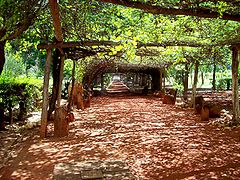
Samay Huasi
Encyclopedia


Argentina
Argentina , officially the Argentine Republic , is the second largest country in South America by land area, after Brazil. It is constituted as a federation of 23 provinces and an autonomous city, Buenos Aires...
functioning as a both a vacation retreat, as well as a museum.
Overview
Located in ChilecitoChilecito
Chilecito is a city in the Argentine province of La Rioja, and head of the department of Chilecito.-Overview:It's located in the valley formed by the Sierras de Velazco to the east, and the Sierras de Famatina to the west. The city was founded in 1715 by Spanish colonizers...
, a town located high in the Pampas Sierras
Sierras pampeanas
The Sierras pampeanas or Pampas Sierras is a geographical region of Argentina.The Sierras pampeanas are a chain of mountains that rise sharply from the surrounding pampa region of Northwest Argentina...
of La Rioja Province
La Rioja Province (Argentina)
La Rioja is a one of the provinces of Argentina and is located in the west of the country. Neighboring provinces are from the north clockwise Catamarca, Córdoba, San Luis and San Juan.-History:...
, the property originally belonged to William Treloar, a British
British Empire
The British Empire comprised the dominions, colonies, protectorates, mandates and other territories ruled or administered by the United Kingdom. It originated with the overseas colonies and trading posts established by England in the late 16th and early 17th centuries. At its height, it was the...
mining engineer who purchased it as a retirement property in the late 19th century. His earlier profession had acquainted him with Dr. Joaquín V. González
Joaquín V. González
Joaquín Víctor González was an Argentine educator, political scientist, writer, magistrate, and politician.- Early life :...
, who was one of the nation's most prominent Mining Law attorneys, and had been Governor of La Rioja from 1889 to 1891. Treloar bequeathed La Carrera, his scenic finca
Estância
Estância is a municipality located in the Brazilian state of Sergipe. Its population was 62,218 and its area is 642 km². The city is the seat of the Roman Catholic Diocese of Estância....
, to his friend, and González inherited the 17 hectare (43 acre) property in 1913.
The new owner kept Treloar's vineyard
Vineyard
A vineyard is a plantation of grape-bearing vines, grown mainly for winemaking, but also raisins, table grapes and non-alcoholic grape juice...
s and orchard
Orchard
An orchard is an intentional planting of trees or shrubs that is maintained for food production. Orchards comprise fruit or nut-producing trees which are grown for commercial production. Orchards are also sometimes a feature of large gardens, where they serve an aesthetic as well as a productive...
s, expanded the living quarters, converted the horse stables into ten bedrooms for each of his sons, and renamed the finca Samay Huasi ("vacation home," in the Quechua language). González, who served as President of the University of La Plata from 1905 to 1913, in turn willed Samay Huasi to the university, and died in 1923.
The University of La Plata formally took possession of Samay Huasi in 1941, and originally maintained it as the Casa de Descanso para Artistas y Escritores, a vacation lodge for artists and writers; the lodge was later reserved of university staff. A portion was set aside in 1960 for the establishment of a museum displaying González's collections of anthropological and geological material, as well as his numerous manuscripts (he published over 50 books and 1,000 articles), and other belongings. The museum was named Mis Montañas in honor of González's 1903 book describing the nearby Talampaya area and other Andes
Andes
The Andes is the world's longest continental mountain range. It is a continual range of highlands along the western coast of South America. This range is about long, about to wide , and of an average height of about .Along its length, the Andes is split into several ranges, which are separated...
landscapes.
Samay Huasi also houses an art gallery
Art gallery
An art gallery or art museum is a building or space for the exhibition of art, usually visual art.Museums can be public or private, but what distinguishes a museum is the ownership of a collection...
, the Antonio Alice Pinacotheca
Pinacotheca
A pinacotheca was a picture gallery in either ancient Greece or ancient Rome. The name is specifically used for the building containing pictures which formed the left wing of the Propylaea on the Acropolis at Athens, Greece. Though Pausanias A pinacotheca was a picture gallery in either ancient...
. Named for Antonio Alice
Antonio Alice
Antonio Alice was an Argentine portrait painter. He was awarded the Prix de Rome in 1904.-Early years:Alice, of Italian descent, was born in Buenos Aires, Argentina. His father, an Italian immigrant, was barely literate...
, an Argentine portraiteur
Portrait painting
Portrait painting is a genre in painting, where the intent is to depict the visual appearance of the subject. Beside human beings, animals, pets and even inanimate objects can be chosen as the subject for a portrait...
and historical painter
History painting
History painting is a genre in painting defined by subject matter rather than an artistic style, depicting a moment in a narrative story, rather than a static subject such as a portrait...
who (among many other works) had created a portrait of González in 1917, the gallery displays art from a variety of Argentine painters.

